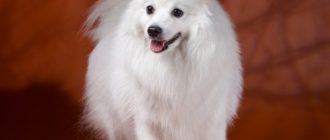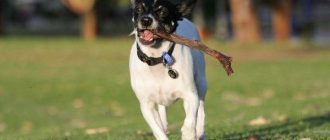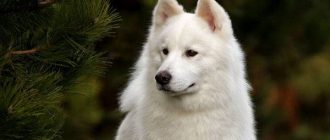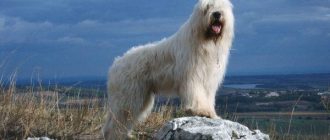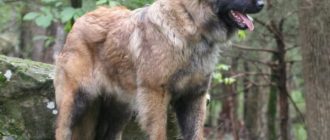Assessment of breed characteristics
Contents
| Adaptability Definition of how easy a dog is. can adapt to changes in life. |  |
| Shedding Level Level and frequency of hair loss in animal. |  |
| Level of tenderness Level and amount of tenderness and affection that the dog gives back in return for attention to itself. |  |
| Need for Exercise Daily Activity Level dogs. |  |
| Social need Required number of dog contacts with other animals as well as people. |  |
| Housing ratio Factor that determines the level of noise and other inconvenience that the dog can deliver to the owners in the ratio apartment size to dog size. |  |
| Grooming Number of bathing, combing, as well as necessary number of professional grooming sessions required the dog. |  |
| Friendliness in an unfamiliar environment society with strangers or in an unfamiliar environment. |  |
| The tendency to bark The tendency to bark and its frequency and volume. |  |
| Health Issues Potential Health Status dogs. |  |
| Territorial tendency of the dog to protect his house, yard or even a car owner. |  |
| Cat friendliness A trend towards cat tolerance and reduced manifestation of hunting instincts. |  |
| Intelligence Dog’s ability to think and solve emerging difficulties (not to be confused with learning!). |  |
| Education and training Level of difficulty in training a dog perform certain actions. |  |
| Friendliness for children Factor determining how much the dog friendly to children, whether she likes to play with them and endure some children’s pranks. |  |
| Game activity The concept is determined by its very name, and, usually found in almost all dogs. |  |
| Observing Dog’s ability to detect presence a stranger in his territory. |  |
| Friendliness for other dogs Dog’s tendency to find common language with other relatives. |  |
Brief description of the breed
Snow-white, fluffy dogs with button eyes are Samoyeds who live side by side for centuries with the peoples of the North. The peoples of the Samoyed group (which otherwise called Samoyeds – Nenets, Enets, Selkups) kept from time immemorial such dogs as sled dogs, they often saved people from creepy cold due to its warm and thick coat. Nowadays Samoyed dogs are loved all over the world not only for their special appearance, but also for a cheerful and playful disposition.
Appearance
Samoyed dogs (often called Samoyeds, or Samoyeds huskies) have a height of about 55-60 cm in males and 50-55 cm in females, weight dogs ranges from 25-30 kg in males and 15-25 kg in females. The body of the Samoyed is strong, slightly longer than the height at the withers, neck developed, muscular, limbs straight, with highly developed musculature, tail high, thrown in excited state on back or sideways. The head of the dogs is wedge-shaped, muzzle gradually tapers towards the nose, ears are erect, have a triangular shape. Samoyed’s particular pride is thick and long coat with soft and fluffy undercoat. Dogs have a luxurious collar around the neck, long hair covers the hind limbs and tail, whereas on the muzzle and forelegs it is much shorter. Color Samoyed wool – white (sometimes with pale fawn marks) or cream.
Samoyed photo:
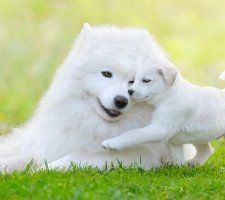
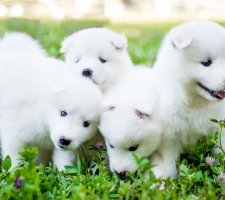

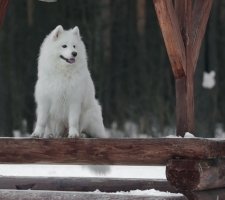


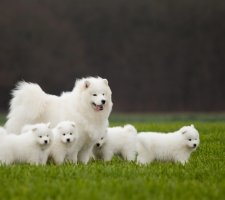
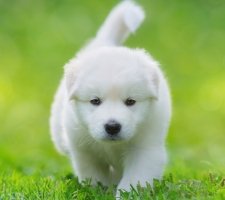
 Photo of dog Samoyed |
Photo of dog Samoyed |
Origin history
It is known for certain that the Samoyed dog is one of the oldest rocks since the first memories of these amazing animals first encountered several hundred centuries ago by the ancestors of the present small ethnic groups of the North. Samoyed dogs allegedly helped people in hunting and gathering as early as the eleventh century BC. The appearance and character of the dog suggests that the breed appeared in the process of domestication of the polar wolf. AND indeed, when comparing a Samoyed dog and a polar wolf, similarities are definitely discernible – the possibility of living in extremely cold conditions, unpretentiousness in food, thick white (or creamy) coat. But such an origin – only one of the versions. According to other versions, the Samoyed dog is a descendant native Nenets huskies (deer Spitz), ancient inhabitants cold tundra. For centuries, these dogs have guarded the plague. the inhabitants of the North from the wolves, helped them during the hunt, accompanied in impassable snowy wilds. But this idea of occurrence The breed is not the last. One of the most common versions. the origin of the breed is the one by which the British scientist E.K. Scott brought in 1889 after traveling to tribal territory Samoyeds to England are several Aboriginal Samoyeds who helped the inhabitants of the North in everyday life. And only then these and others native dogs were crossed to breed a new breed – Samoyed. By the way, there are several different options for the appearance and the spread of samoyeds. Who knows exactly where the truth was. One thing is known – the homeland of the Samoyeds is the territory of the present Russian Federation.
Samoyed character
Samoyed dogs have a loving nature, they kindly treat not only members of their family, but also those who came to the house with kindness and an open heart. Noticed that Samoyeds until old age (and they live until about 12-15 years old) retain a love of games and a vibrant lifestyle. Sometimes these animals try to stand their ground, as if opposing teams the owner, but also in this lies a certain element of the game. Samoyeds most often get along well in families (including with children), communication with them necessary like air. The rest of the host pets tolerant, alien animals may not like. Samoyed dog is not should be wound up as an aggressive guard. These dogs are not they are in fact, moreover, they rarely give voice in the case and without. Samoyeds are unpretentious in everyday life, extremely hardy (they can carry a load weighing 1.5-2 times their own weight), respond with affection and loyalty to their master. Maybe, one of the breeds should not be distinguished, belittling others, however, when you look at a Samoyed dog, feelings appear tenderness from the true beauty that was created on our Earth.
Maintenance and care
Samoyed dogs can live both indoors and on sections of suburban or private houses, subject to equipment for them aviary and booths. They tolerate heat well, and especially cold. It is necessary to equip a dog’s berth in a measure of rigid and spacious couch, close to which should stand around the clock a bowl of water. First of all, the new owner of the Samoyed should decide what the role of the dog will be in the future. Will it grow from a puppy a simple home friend or a champion with titles. From this it follows that the care of the dog, of course, can be different – more complicated and meticulous, if in the future a samoyed expects an exhibition a life. But if the owner does not plan to make a dog a celebrity, then (surprisingly) there will be nothing difficult to care for. Consider Features of caring for a domestic dog. Snow-white wool Samoyed dogs require shampooing no more than 1-2 times a year, since Samoyeds have a unique property of self-cleaning wool. They practically have no specific smell characteristic of many fluffy dogs. Shedding occurs 1 (in males) or 2 (in bitches) once a year. Thick coat all season (and especially when molting) requires careful combing with brushes and slickers. Regular combing and is the best cleaning of a dog’s fur coat. As Samoyeds need to clean their ears with cotton pads with using cleansers. Claws of Samoyeds must to be cut by the owner with a clipper, and the fur around the fingertips should be removed carefully with scissors. The nutrition of these dogs cannot be given any specific advice. It is advisable to ask the breeder before buying a dog about a diet that was “native” to the puppy. A sharp change in nutrition can negatively affect the dog’s digestive system. Further Samoyed will gladly gobble up as ready (only quality) dry food, and prepared by the owner. But not you should feed the dog food from the table, even if the Samoyeds are practically omnivores, but plentiful in spices, fatty and fried foods certainly not will benefit the animal. Since Samoyeds – dogs are funny and active, it is advisable to walk them at least 2 times a day, moreover preferably active pastime. In extreme heat a dog can feel bad due to overheating, therefore it is more reasonable make a promenade in the morning and evening hours. Nice to get special toys for dogs – tweeters, bones, balls. Communication and playing with a dog of this breed is an indispensable condition of keeping.
Training and training
Puppy training for the simplest teams should start no earlier than 3 months. But the owner should from the very first days during the walk and At home, be persistent in raising a Samoyed baby. TO for example, even if you really want to, do not let the dog beg for food from the table or sleep in the master’s bed. Samoyeds quite smart and savvy, therefore, sensing slack once, they will continue to insist on their own. Puppy must be trained teams: “Fu”, “You can not”, “To me” and others. After successful Fulfillment of the owner’s order should encourage and praise the dog. IN in case of disobedience, screaming, let alone beating the Samoyed, is not worth it. When the animal gets stronger and learns to respond implicitly to owner’s voice, it’s worth doing real training under supervision an instructor who will explain all the nuances of training this breed. By Samoyed owners say these dogs are well trained, although sometimes they are stubborn. Therefore, it’s important to show the dog correctly, that primacy always remains with the master.
Health and Disease
Most often, Samoyeds are healthy guys, but there are diseases that still found in them. Such unpleasant diseases include:
- Eye diseases (cataracts, primary glaucoma, atrophy and retinal dysplasia) – the owner should pay attention to symptoms: redness of the eyes, clouding of the lens, lacrimation, depressed state of the dog, etc .;
- Diseases of the cardiovascular system (aortic stenosis) – the animal suffers from shortness of breath, mucous membranes may turn blue shells, fainting;
- Liver disease (portosystemic shunt) – symptoms often absent, sometimes underweight, poor condition of coat, gastrointestinal tract disorders;
- Kidney Disease (Renal Dysplasia and Insufficiency) – Race temperature, increased thirst, vomiting, rare urination, and others;
- Diseases associated with metabolic disorders (diabetes, etc.) – changes in appetite, weakness, gastrointestinal disorders, thirst and others;
- Joint diseases (hip dysplasia, osteoarthritis) – lameness, fatigue, gait changes;
- Hearing impairment (congenital deafness) – the dog has no reaction to call, command, coordination of movements is often disturbed.
Despite the above list, Samoyeds are more likely healthy dogs. But if alarm calls are detected, the owner should Call a veterinarian immediately for help. Important for Samoyeds, as with other dog breeds, timely vaccinations. Pest control measures should also carried out by the owner on time.

